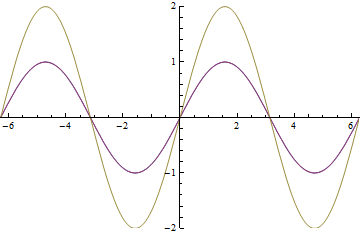Amplitude modulation is very similar to phase modulation. In all previous types of modulation we split the beam up into two different oppositely polarized beams only to use one in the modulation process. In the case of amplitude modulation we still only send one beam through the EoM, but we are still in need of the second beam. The set up for amplitude modulation can be seen below.
In this set up there is a half wave plate to change the direction of the polarization of the laser beam entering the EoM to be identical to the one not going into the EoM. The EoM is used to modulate the phase of the beam exiting it. There are two polarizing beam splitter cubes that are used as one-way mirrors so the two beams can be joined back together. Being able to change the phase of one of the beams allows you to control how much constructive interference and how much destructive interference occurs when the beams add together as shown in the animation below.
The blue wave is the laser beam that is not going through the EoM, the red wave is the beam that is having its phase modulated from 0 to ![]() as it passes through the EoM. The yellow wave is resultant amplitude modulation.
as it passes through the EoM. The yellow wave is resultant amplitude modulation.
As you can see from the animation you are able to control the amplitude of the laser beam any where from 0 to twice the original amplitude.




Your diagram and explanation are great- sweet MS Paint skills.